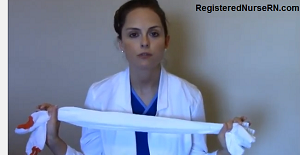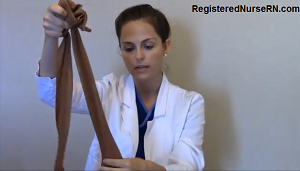As a nurse or nursing student you may have heard other people say they wear TED hoses or compression stockings. In the nursing world people use TED hoses and compression stockings interchangeably. However, there is a difference between TED hoses and compression stockings. Although, both are compression stockings, they each perform a different purpose.
What are TED Hoses?
 TED stands Thrombo-Embolic-Deterrent which means that they prevent blood clots. TED hoses come in knee high and thigh high and various colors. TED hoses are meant to be worn by people who are post-opt or bed ridden to prevent blood clots. After surgery or when a patient isn’t able to walk the blood pools in the lower extremities which can lead to a blood clot.
TED stands Thrombo-Embolic-Deterrent which means that they prevent blood clots. TED hoses come in knee high and thigh high and various colors. TED hoses are meant to be worn by people who are post-opt or bed ridden to prevent blood clots. After surgery or when a patient isn’t able to walk the blood pools in the lower extremities which can lead to a blood clot.
*Ted hoses provides compression like if the patient was walking to help keep the blood from pooling in the leg. So TED hoses are for people who can not walk. Hence, they are not ideal for nurses. In addition, TED hoses are only good for about 3 weeks and should then be re-placed with a new pair.
What are Compression Stockings for Nurses?
 *Compression stockings for nurses
*Compression stockings for nurses are compression hoses (sort of look like the material of panty hoses), unlike TED hoses, that have compression in the ankle area of the stocking. Compression stockings are for people who are able to walk but suffer from leg fatigue, varicose veins (or at risk from them), lymphedema (swelling of the legs) etc.
They work best in people who are on their feet a lot, by delivering compression at the ankle area which in turns prevents blood and fluid from pooling in the ankle. When blood and fluid pools in the ankle it causes stress on the veins which can cause them to break and form varicose or spider veins.
Compression stockings come in various compression ratings such as: 15-20 mmHg, 20-30 mmHg, 30-40 mmHg. Generally 15-20 mmHg is sufficient for a nurse and they also come in thigh high or knee high length. Compression stockings usually last 6 months until a new pair is needed.
*See disclosure at the end of this post.
Do I need Compression Stocking or TED Hoses as a Nurse & Nursing Student?
Based on the differences between TED hoses and Compression Stockings, it is best to go with a pair of compression stockings for nurses. They will work better to help prevent leg fatigue and varicose veins. TED hoses are made to prevent blood clots and for people who are non-ambulatory. Compression stockings are made for ambulatory people like nurses.
Video about the Difference between TED Hoses and Compression Stockings
*Disclosure: The items recommended in this article are recommendations based on our own honest personal opinion and experience. We are an affiliate with Amazon.com, and when you buy the products recommended by us, you help support this site.